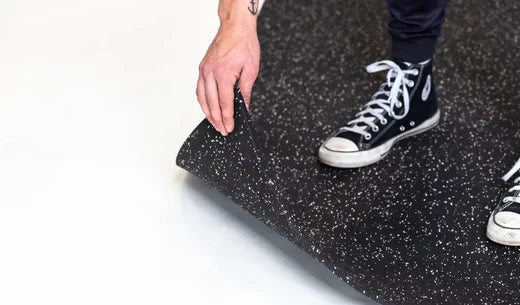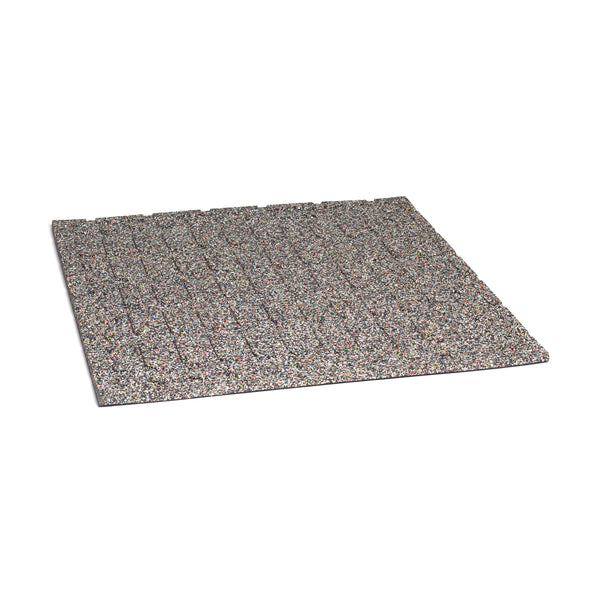When it comes to setting up your dream garage gym, you're not just building a place to lift weights; you're crafting a sanctuary for your gains.
But before you start bench pressing like a beast or deadlifting like a pro, you need to address a fundamental question: What's the best flooring for your garage gym?
After all, the last thing you want is to turn your workout space into a comedy of slip-ups and accidents. So, let's dive right in and explore the ins and outs of garage gym flooring.Garage gym flooring isn't a one-size-fits-all affair. It's a battlefield where your weights clash with gravity, and you need a floor that can take a beating. Here are some common issues you might encounter:
1. Uneven Surfaces
Garage floors are notorious for their unevenness. You don't want your barbell to roll away mid-squat because of an uneven surface. It's like your gym is playing a prank on you!
2. Impact Protection
Your joints are precious, and they deserve some love. Concrete floors are harsh on your knees, hips, and back. You need flooring that cushions your landings when you're hitting those heavy deadlifts.
3. Durability
Weights are heavy, and they will leave their mark if your flooring isn't up to par. You want a surface that can withstand the wrath of your iron plates.
4. Easy Maintenance
Sweat, chalk, and the occasional protein shake spill are par for the course in any gym. You need a floor that's easy to clean and maintain because ain't nobody got time for scrubbing grime between sets.Before you start laying down your ideal gym flooring, you'll want to ensure your garage floor is as level as possible. Here's how you can do it:
1. Inspect and Clean
- Sweep away debris and dirt.
- Fill any cracks or holes with concrete filler.
- Ensure there are no major structural issues that require professional attention.
2. Use Self-Leveling Compound
The self-leveling compound is like magic for uneven floors. Pour it over the surface, and it will spread out to create a smooth, level base.
3. Wait for It to Dry
Patience is key here. Let the compound dry completely before moving on to your flooring installation.Now that you've got a level playing field, it's time to choose the right flooring for your garage gym. Here are some popular options:
1. Rubber Gym Mats
-
Pros:
- Excellent shock absorption.
- Protects your equipment from damage.
- Easy to clean.
- DIY installation.
- Affordable.
-
Cons:
- May have a rubbery smell initially.
- Can be heavy to move around.
Rubber gym mats are a solid choice for garage gym flooring. They provide the cushioning you need while being tough enough to handle heavy weights. Plus, they're easy to install, making them a great DIY option.
2. Interlocking Foam Tiles
-
Pros:
- Exceptional cushioning.
- Easy to install and replace.
- Great for high-impact workouts.
- Variety of colors and patterns available.
-
Cons:
- Not as durable as rubber.
- May compress over time.
Interlocking foam tiles are like workout puzzle pieces for your garage gym. They're soft on your feet and joints, making them ideal for intense workouts. Just remember that they might not last as long as rubber options. These are a great option for some extra, portable cushioning over rubber flooring.
3. Plywood Platform
-
Pros:
- Customizable size and thickness.
- Provides a stable surface for heavy lifting.
- Can be combined with rubber mats for extra protection.
-
Cons:
- Requires more DIY effort.
- Not as cushioned as rubber or foam.
If you're a DIY enthusiast and want to create a lifting platform, plywood is your go-to material. It's sturdy and can handle the weight, but you might want to pair it with some rubber mats for added protection. For rubber gym mats, 3/8 to 1/2 inch is a good thickness. Foam tiles can vary, but aim for at least 3/4 inch for adequate cushioning. Read the full flooring thickness guide here. While it might save you a few bucks, regular carpet won't provide the necessary support and durability for a garage gym. Stick to purpose-built gym flooring.
The cost varies depending on the type and brand of flooring you choose. Rubber mats are generally more budget-friendly, while foam tiles and plywood platforms might be a bit pricier. Most gym flooring can be easily cleaned with a broom, mop, and some mild detergent. Rubber mats are especially low-maintenance. Your garage gym should be a temple of strength, not a comedy club for slip-ups and accidents.
Choosing the right flooring is crucial for a safe and effective workout space. Whether you opt for rubber gym mats, foam tiles, or a plywood platform, make sure it suits your needs, budget, and DIY skills.
So, go ahead, pick the perfect flooring, and let the gains begin!



